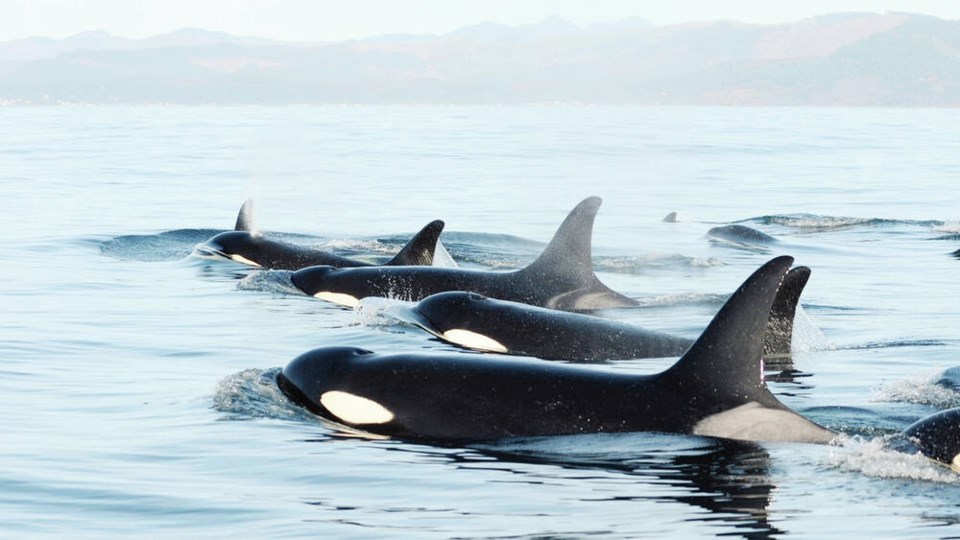Environmental groups have issued a scathing review of some whale watchers and the lack of enforcement by Transport Canada to protect the endangered southern resident orcas.
The groups say some whale-watching companies and recreational fishers in the Salish Sea are “routinely” violating a buffer zone of 400 metres, and sometimes are “pursuing” the orcas into U.S. waters.
The David Suzuki Foundation, Georgia Strait Alliance, Natural Resources Defense Council, Raincoast Conservation Foundation and WWF Canada are calling for increased enforcement, prosecutions and penalties to deter the “bad actions of a few” in the whale-watching and recreational-fishing industries.
The 73 remaining southern resident killer whales in J-, K- and L-pods are struggling to survive after the deaths this summer of K-21 and L-47.
Straitwatch, a Victoria-based marine mammal and vessel behaviour program, said during 12 out of 24 days of monitoring the whales in the summer of 2020, Canadian whale-watching operators were observed 84 times within 400 metres of southern resident orcas.
In nearly one third of these instances, operators went within 100 or 200 metres of the orcas. Over the same season, 51 recreational fishing vessels were observed within 400 metres of southern residents, with 28 of those within 200 metres.
Paul Pudwell, who operates Sooke Whale Watching, said all Pacific Whale Watch Association members in the Canadian Salish Sea have signed agreements with the federal government to stay away from the southern residents in exchange for a 200-metre buffer to watch transient orcas.
The penalties for not doing so range up to $1 million, he said.
“We avoid [southern residents] like the plague,” said Pudwell. “On the two occasions I have come across [southern residents] this summer, I put it out there on the radio and everyone gets out of the area.”
Pudwell said reputable whale watchers “know what’s at stake” with the southern residents. “We love these whales and we’re not going to risk a $1-million fine,” he said.
“We’ve seen hundreds of transients and thousands of humpback whales … we don’t have to look at [southern residents], but we do tell our guests about them for educational purposes.”
Erin Gless, executive director of the Pacific Whale Watch Association based in Friday Harbor, Washington, said it can take some time for members to photograph and identify the whales. “Once they figure it out, I can assure you they respond by leaving the scene,” she said.
The association has 29 member companies — about half of them based in Canada — who take out more than 500,000 guests per year.
The distancing rules in U.S. waters for vessels and southern resident orcas is less than in Canada at 300 yards, or 275 metres.
Gless agreed with the call for more enforcement, but said of the 84 incidents in 2020, only five distancing infractions were in Canada. The other 79 were in U.S. waters, “where it’s legal [for all members] to view southern residents from 300 yards,” she said.
No whale-watching companies were mentioned by name in the report.
In Canadian Salish Sea waters, whale-watching operators are obliged to forgo watching southern resident killer whales under the Sustainable Whale Watch Agreement with Transport Canada.
However, the report said over seven days in 2020, Canadian operators were observed more than 30 times watching southern residents in Canadian waters for more than 30 minutes and, in some instances, for more than 60 minutes.
“This report shows how many broke that trust — and the law — putting these endangered whales in harm’s way,” said Jeffery Young, senior science and policy analyst with the David Suzuki Foundation. “It’s time the federal government fully prosecutes the worst offenders.”
The report said Canadian whale-watching operators were crossing into U.S. waters. In total — in Canada and the U.S. — they were observed watching southern residents 180 times over the 12 days of monitoring in 2020, viewing the whales for more than 30 minutes.
Straitwatch said in its report that enforcement of the distancing rules by officials is lacking, especially on the Canadian side with Transport Canada and the Department of Fisheries and Oceans.
Washington State Department of Fish and Wildlife was present with southern residents in U.S. waters about 20 per cent of the time. Canadian enforcement vessels have been present on average two per cent of the time, with no notable increase in presence with southern resident orcas, the report said.
Calls to Transport Canada to respond to the report were not returned. On its website, Transport Canada said it is hiring more fisheries officers to beef up enforcement around the Species at Risk Act and increase aircraft patrols.
“Canada doesn’t have enough eyes on the water around southern residents,” says Misty MacDuffee, wild salmon program director at Raincoast Conservation Foundation. “Fisheries and Oceans Canada needs to be present when endangered whales are in the Salish Sea.”



